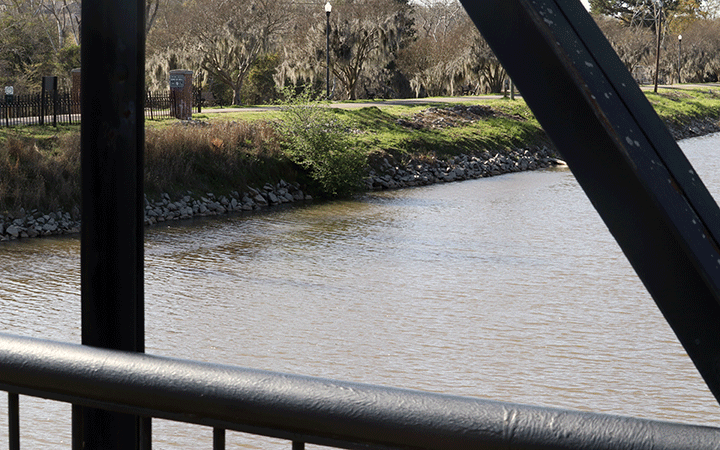The Congaree River is one of many surface water sources that surpasses the proposed maximum for two dangerous “forever chemicals.” (Photos by Jacob Phillips)
Nearly every surface water source in South Carolina has tested positive for “forever chemicals,” according to state environmental officials.
Many sources, in fact, contain more than the new proposed federal maximum for the chemicals, the S.C. Department of Health and Environmental Control said Wednesday.
In March, the Environmental Protection Agency announced a new maximum contaminant level for six per- and polyfluoroalkyl substances – or PFAS – in drinking water.
And most all drinking water in South Carolina is drawn from surface water, not aquifers.
“Some of our larger drinking water systems, they have intakes or withdrawal water from surface water,” DHEC’s Bureau of Water Chief Jennifer Hughs said. “So from a drinking water perspective, there’s a lot of interest in the data we’re seeing in our ambient surface water project.”
Perfluorobutane sulfonic acid (PFOS) and perfluorooctanoic acid (PFOA) are two types of PFAS found in almost all South Carolina waterways. Overconsuming those can be harmful.
That’s why the EPA announced a proposed max of 4-parts-per-trillion for both PFOS and PFOA but said the goal should be zero.
DHEC announced last month it was preparing to crack down on those contaminants in drinking water, anticipating that the EPA soon would do the same.
State officials test for 26 types of PFAS quarterly from more than 100 streams, rivers, lakes and coastal sites. Almost all sites tested positive for PFAS but at a variety of concentrations.
DHEC also has been testing for PFAS in the tissue of consumable marine life, including various fish, oysters and blue crabs.
“We know that to address PFAS, we have to have sound science and data to make informed decisions,” Hughs said. “PFAS (are) very complex and challenging. Knowing and understanding that, we developed our strategies in a very methodical and intentional manner to address those complexities.”
Richland and Lexington counties feature four major river basins, the Broad, Catawba, Edisto and Saluda.
In Columbia, the Saluda and the Broad merge to form the Congaree, which flows into the swampy waters of the Congaree National Park before heading to the coast.
Each basin consists of multiple surface water sites, some of which are used for drinking water.
The most recent round of surface water testing has shown concerning results.
In the Broad Basin, 26 of 36 sites tested exceed the proposed limit for either PFOA or PFOS, and 14 exceeded both of the chemicals.
In the Catawba Basin, 10 of 19 sites exceed the level for both.
There were seven sites that exceeded the max in the Edisto. But only two sites exceeded the number for both chemicals.
In the Saluda River Basin, 23 of 33 sites topped the requirements, and all but three of those exceeded both.
The portion of the Broad River in Columbia had about 8 parts per trillion PFOA and 7 parts per trillion PFOS – about twice as high as they should be under the proposed federal guidelines.
Nearby creeks are also affected.
Gills Creek in Columbia and Six Mile Creek in Cayce exceeded 10 parts per trillion in both PFOA and PFOS.
Six Mile Creek contained 50 parts per trillion PFOS, over 12 times the proposed maximum.
The chemicals also have been found in multiple aquifers, which could affect people who use private wells.
Environmental officials have said they can’t yet determine what specifically caused the contaminations or which areas have been hit the hardest.
But they’re beginning to study it.
“That’s a critically important question, and that’s one that we do aim to address with the design of this project,” DHEC environmental scientist Dr. Matt Baumann said. “It’s a bit too soon to draw a conclusion on seasonality or what our PFAS contributors might be.”
The problem appears to be nationwide.
Common places that contribute to PFAS contamination include airports, landfills, industrial sites and sludge application sites.
DHEC has completed three of four rounds of planned tests at its surface water sites. Data collection is expected to finish in June.
Some sites already have expressed concerns about their ability to treat the water and meet EPA standards.
Utility sites have said money, equipment and other logistical issues would make it challenging to reach the proposed goal.
“We’ve been having conversations with a lot of our utilities ever since the proposed (maximum) came out,” said Doug Kinard, Bureau of Water Division director for DHEC. “We’ve got a little bit of time before it becomes final. And we plan to continue to have those discussions with our board of utilities and try to figure out how best to address this.”
Water companies will have around three years to comply with federal standards after the list of proposed maximums is finalized. The EPA expects to be done by the end of the year.
Until then, DHEC has urged residents and utility companies to express their thoughts during the EPA’s public comment period, which is open until May 30.
Health officials also reiterated the need for the public to remain informed on the latest developments relating to drinking water and educate themselves on which consumer products contain PFAS.
Products that contain the chemicals include food packaging, microwaved popcorn, cosmetics, treated fabrics and carpets, non-stick cookware and dental floss, among others.
“This is an issue that has taken many, many years to result in the issue that we have before us,” said Myra Reece, the environmental affairs director for DHEC. “We can give you some information on how you can determine the levels. … We can share that information and work with you and give you information on steps that you can take to reduce those levels.”



